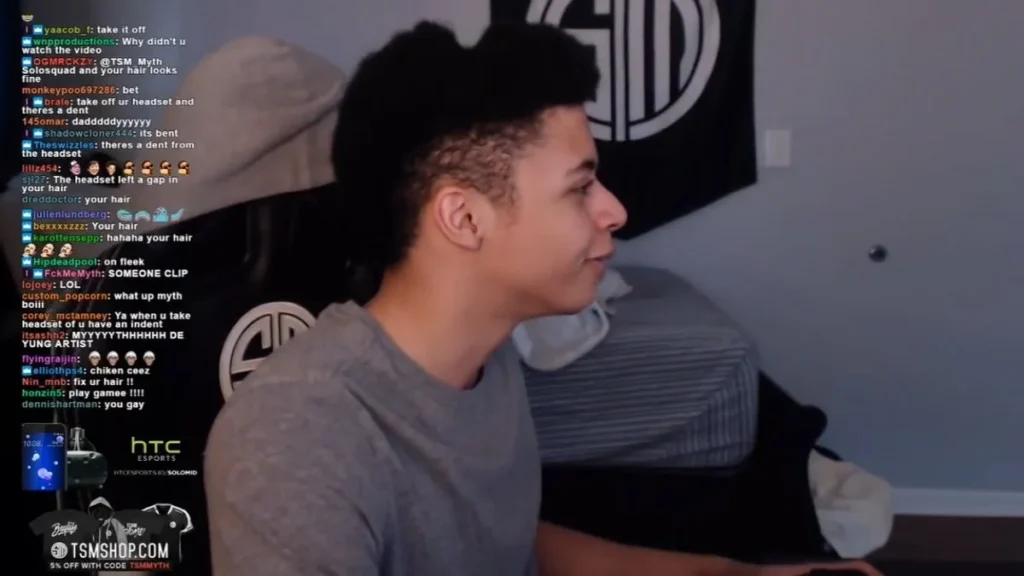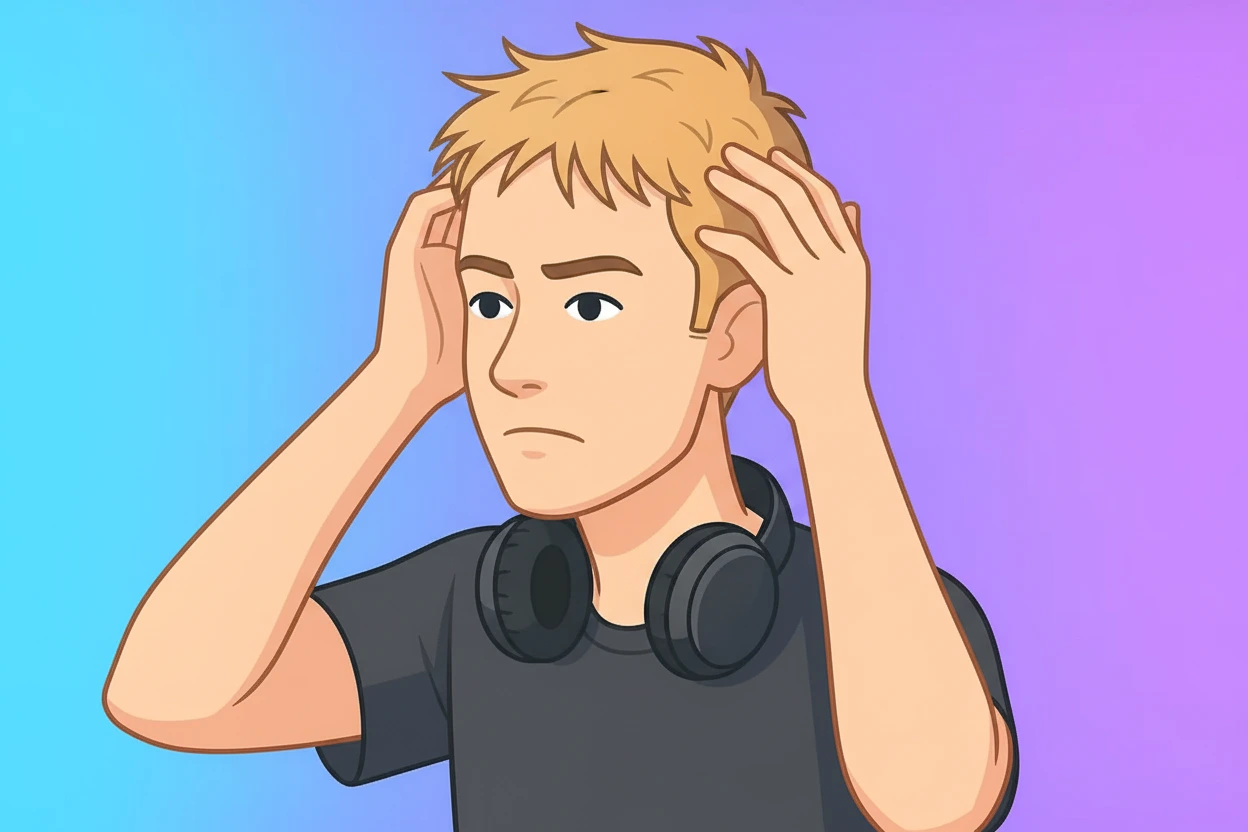If you have ever finished a long gaming session or a day of remote work, taken off your headphones, and been greeted by a distinct dent across your hair, you have experienced “headphone hair.”
With headphones now being an essential part of daily life for work, entertainment, and travel, this cosmetic annoyance is more common than ever.
The global market for earphones and headphones was valued at over $71 billion in 2023 and is projected to grow, showing just how integrated these devices are in our lives.
Fortunately, that annoying dent is not permanent, and you do not have to choose between great audio and great hair. This guide explains what causes headphone hair, provides simple tips to prevent it, and offers quick fixes for when it happens.
Key Takeaways
- Headphone hair is caused by sustained pressure from a headband, combined with heat and moisture, which temporarily flattens the hair’s structure.
- The best prevention methods involve distributing pressure by shifting the headband, using a physical barrier like a beanie, or choosing a hairstyle that lifts the hair.
- The fastest way to remove a dent is to dampen the hair with water and fluff the roots.
- Choose lightweight headphones with a wide, padded, or suspension-style headband to minimize pressure.
What Causes Headphone Hair?
Headphone hair is a temporary dent caused by the sustained pressure of a headphone’s headband on your hair and scalp.

This pressure, combined with natural heat and moisture, temporarily molds the hair’s protein structure into a flattened shape. Understanding the mechanics of how headphones work and exert force is the first step to solving the problem.
The main factors are straightforward: pressure and moisture. Your hair is made of a protein called keratin, which is surprisingly malleable when warm or damp.
The constant pressure from a headband, especially a narrow one, concentrates the device’s weight onto a small area. Product testing shows that the crown of the head can bear up to 60% of a headphone’s total pressure, which is why the dent is most prominent there.
When this pressure is combined with your scalp’s natural heat and any residual moisture in your hair, it effectively steam-sets a crease into place.
Easy Tips to Avoid Headphone Hair
The most effective way to prevent headphone hair is to minimize continuous pressure on any single spot and keep your hair completely dry before wearing your device.
Simple adjustments to your hairstyle, headphone position, and listening habits can make a significant difference.
Since research indicates that hair deformation becomes much more pronounced after two hours of continuous wear, taking breaks is a scientifically sound strategy.
Here are 12 easy tips to keep your hair looking its best:
1) Ensure Your Hair Is Completely Dry
This is the most important rule. Even slightly damp hair is easily molded, so always make sure your hair is 100% dry before a long listening session.
2) Shift the Headband Position
Periodically move the headband slightly forward or backward from its usual spot. This prevents pressure from concentrating on one area for too long.
3) Wear a Physical Barrier
A thin, soft beanie, a silk scarf, or the hood of a sweatshirt can act as a cushion. This extra layer helps distribute pressure more evenly and reduces friction.
4) Use a High Ponytail or Bun
For those with long hair, tying it up in a high ponytail or bun where the headband sits allows the band to rest on the hair tie instead of directly on your hair.
5) Try a Different Part
Part your hair on the opposite side before putting your headphones on. When you flip it back to its normal part after your session, the roots will have more volume.
6) Take Regular Breaks
Give your hair and scalp a break by removing your headphones for a few minutes every hour. This allows your hair to decompress and helps prevent a deep dent from setting in.
7) Use a Light Hair Product
A small amount of volumizing mousse or texture spray at the roots can add structure, making your hair more resistant to flattening. Avoid heavy gels or waxes that can make hair sticky and transfer to your headphone pads.
8) Adjust the Fit
Make sure your headphones are not too tight. An adjustable headband should be snug enough to be secure but not so tight that it digs into your scalp.
9) Try an Unconventional Position
Some users wear the headband at the back of their neck or under their chin. While this can look unusual, it completely eliminates pressure on the top of your head.
10) Keep Your Headphones Clean
Buildup of oil and hair products on the pads can make your hair feel greasy and contribute to flattening. Learning how to clean headphones properly helps maintain both your hair and your equipment.
11) Choose a Shorter or Longer Hairstyle
Very short hair is less likely to show a dent, while very long hair can be styled in ways (like a bun) that create a buffer. Medium-length hair is often the most susceptible to noticeable dents.
12) Opt for Earbuds or IEMs
The most foolproof solution is to use in-ear headphones or earbuds. Since they make no contact with the top of your head, they completely eliminate the possibility of headphone hair.
How to Fix Headphone Hair When It Happens
The quickest way to fix headphone hair is to reintroduce moisture to the affected area with a small amount of water and fluff the roots. For more stubborn dents, a blow dryer can be used to restore volume and shape.

If you find yourself with a dent and need a quick fix, here are a few simple methods:
- The Water Trick: This is the most effective solution. Dampen your fingers or a comb with water and work it into the roots of the dented area. Fluff the hair up and let it air dry or give it a quick 20-second blast with a blow dryer.
- Use a Blow Dryer: For a more styled fix, use a blow dryer and a brush to lift the roots and restore volume to the flattened section of your hair.
- Massage Your Scalp: Gently massaging the dented area with your fingertips can help stimulate blood flow and lift the hair roots, making the dent less noticeable.
Choosing Headphones to Prevent Hair Dents
Selecting headphones with a design that distributes weight effectively, such as those with a wide or suspension-style headband, is key to preventing hair dents.
In general, headphones that are lightweight and have a lower clamping force will exert less pressure on your hair and scalp.
How a headphone is built is the root cause of headphone hair. While many factors contribute to comfort, the headband architecture is the most critical.
| Headband Type | Weight Distribution | Best For |
| Traditional Padded | Concentrated on a single contact strip. | General use; effective when wide and well-padded. |
| Suspension Strap | Distributed across a wider, flexible strap. | Heavier headphones and long-duration use. |
| 3D Wing Support | Rests on two small pads on the upper sides of the head. | Users sensitive to any top-of-head pressure. |
When shopping, also consider the difference between over-ear vs on-ear headphones. Over-ear models are generally more comfortable for long sessions as they surround the ear instead of pressing on it.
Finally, look for models marketed as lightweight headphones, a good benchmark is anything under 9 ounces (about 255g).
Can Headphones Cause Hair Loss?
Standard headphone use does not cause hair loss, and the temporary “headphone dent” is an impression on the soft tissue, not the skull.
While excessively tight headphones could theoretically contribute to traction alopecia over time, this is rare and distinct from common male or female pattern baldness.
A common concern, often amplified by viral social media posts, is the fear of a permanent “gamer dent” or skull indentation. This is a myth.
Scientific studies show that it takes a significant amount of force, at least 135 kg (around 300 lbs) to cause even a minor fracture to the human skull.
The pressure from headphones is nowhere near that level and only affects your skin and hair. You can learn more about headphone dent to understand why it’s a temporary cosmetic issue.
When choosing a new device, paying attention to key headphone specifications like weight and clamping force can help you find a comfortable and secure fit that won’t damage your hair.
Conclusion
Headphone hair is a common but manageable side effect of our modern, audio-filled lives. By understanding that it is caused by simple pressure and moisture, you can take proactive steps to prevent it.
From simple hairstyle adjustments and regular breaks to choosing headphones with a more ergonomic design, you have plenty of options to keep your hair looking fresh. And for those times when a dent still appears, a little water and a quick fluff are all you need to fix it.
At SoundHub, we believe that great audio should enhance your life without any hassle. For more practical audio guides and tested tips that keep listening easy on your head, follow our blog for regular updates.
FAQs
1) Can Wearing Headphones Cause Permanent Hair Loss?
Frequent and prolonged use of tightly fitting headphones can cause traction alopecia, a form of hair loss, but it is generally preventable with the right precautions and the use of proven hair loss treatments for men and women.
2) Are There Specific Headphones That Prevent Headphone Hair?
While no headphones can completely prevent headphone hair, models with padded, wider, or fabric-wrapped bands tend to minimize hair denting.
3) How to Fix Headphone Hair?
The quickest fix for a headphone dent is water. Lightly dampen the affected hair with a spray bottle or your fingers, then fluff the roots.
4) How to Get Rid of Headphone Hair?
To get rid of headphone hair, dampen the dented area and massage your scalp to lift the roots. For a stubborn crease, use a blow dryer and a brush to add volume back into the flattened area.



